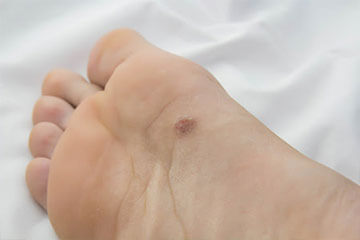
Skin growths and tumors can develop anywhere-even on the feet and under the toenails. Not all growths on the feet are cancerous. However, those that are cancerous usually are caused by viruses, chemical exposure, inflammations or genetics-unlike other cancerous skin growths on the body which are typically caused by overexposure to the sun’s harmful rays.
A granuloma in the foot, ankle, or toe (granuloma annulare) is a noncancerous inflammation of the skin that causes discolored lumps or a rash to develop under the skin. Skin trauma, insect bites, certain medications, hepatitis C, or the human immunodeficiency virus (HIV) can sometimes cause this type of growth in the foot.
Squamous cell carcinoma is a common form of skin cancer, and the most common type to develop on the foot. It can present as plaque or a scaly bump, and may be mistaken for a callus, plantar wart, fungal infection, or eczema. In some cases a squamous cell carcinoma may bleed, crack, or be itchy. It is important to catch this type of cancer early (when it stays local to the skin) before it advances to become more aggressive and may spread.
A basal cell carcinoma is rare on the foot since this type of cancer usually occurs on skin surfaces that are exposed to the sun. Luckily, this type of cancer is the least aggressive type of cancer and usually remains local. These lesions can look like white patches or bumps which can sometimes crust over or ooze.
Malignant melanoma is an extremely serious form of cancer which can develop on the top or sole of the foot, or under the nail. It is critical to detect and treat this type of growth very early, to help prevent it from spreading throughout the body. A malignant melanoma may appear as a spot or bump that is either brownish-black or pinkish/red. These potentially deadly growths can sometimes be mistaken for a mole, plantar wart, bruise, blood blister, or ulcer. Under the nail, it may present as brown or black streaks, or a nodule or bruise that does not move as the nail grows in.
If this type of irregularity appears under your nail, or there is a growth on your foot larger than 6mm (approx. 1/4”) with uneven coloring, asymmetric sides, or uneven or ragged borders, see your podiatrist as soon as possible.

